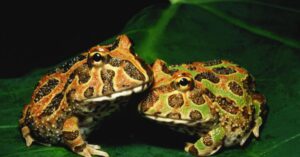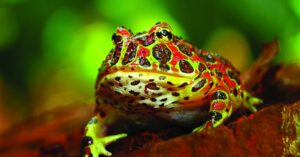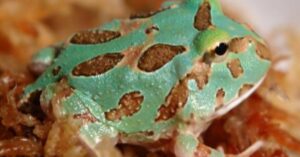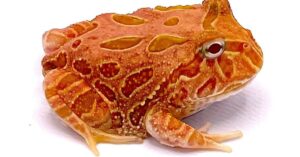🐸 How to Set Up a Bioactive Pacman Frog Terrarium
Create a Natural, Self-Cleaning Habitat for Your Horned Frog
Bioactive Pacman Frog Terrarium - At a Glance
A bioactive terrarium mimics a natural ecosystem using living soil, cleanup crew insects, and live plants. For Pacman frogs, this setup enhances humidity, reduces waste buildup, and promotes a healthier, more stable environment. Learn how to build a bioactive enclosure from the ground up with our step-by-step guide.
A bioactive enclosure is more than just a beautiful tank—it’s a living system designed to clean itself, regulate moisture, and support your frog’s natural behaviors. While traditional Pacman frog setups require frequent cleanings, bioactive terrariums break down waste naturally, reducing maintenance and creating a healthier long-term environment.
In this guide, you’ll learn how to properly build and maintain a bioactive habitat for your Pacman frog, even if you’re a first-time amphibian keeper.
What Is a Bioactive Terrarium?
A bioactive setup includes:
Drainage layer for water runoff
Living soil layers to support plant roots
Live plants for humidity and aesthetics
Microfauna (cleanup crew) like springtails and isopods that eat waste and mold
For Pacman frogs, this system supports moisture, reduces ammonia buildup, and promotes digging and burrowing.
Note: Bioactive terrariums are low-maintenance—not no-maintenance.
Supplies You’ll Need
| Category | Items |
|---|---|
| Enclosure | 10–20 gallon glass tank with secure lid |
| Drainage layer | Hydroballs, LECA, or lava rock + mesh screen |
| Substrate layer | ABG mix, coconut fiber, organic topsoil, leaf litter |
| Cleanup crew | Springtails and dwarf white isopods |
| Plants | Pothos, ferns, bromeliads, mosses (frog-safe only) |
| Tools | Misting bottle, hygrometer, grow light (optional), tongs, spray wand |
Step-by-Step: How to Set Up a Bioactive Pacman Frog Enclosure
Step 1: Add a Drainage Layer
A drainage layer prevents standing water and root rot.
Add 1–2 inches of LECA or hydroballs to the tank base
Place a fine mesh screen on top to separate soil from water
Optionally, insert a drainage pipe or access straw for water removal
Step 2: Build Your Substrate
Layer the soil mix on top of the drainage base.
Recommended Mix:
40% coconut fiber (moisture retention)
40% organic topsoil (structure)
20% sphagnum moss or orchid bark (aeration)
Top with leaf litter or dried moss
Layer at least 3–4 inches deep for burrowing comfort.
Step 3: Introduce the Cleanup Crew
Add your detritivore insects before your frog.
Springtails: tiny, white bugs that eat mold and waste
Dwarf white isopods: burrow and break down organic matter
Release into the substrate, mist, and let them settle for 1–2 weeks
Let the bioactive cycle establish before adding your frog.
Step 4: Add Live Plants
Choose hardy, frog-safe plants:
Pothos
Heartleaf philodendron
Ferns (rabbit’s foot or lemon button)
Moss patches (sheet or pillow moss)
Plant deeply and pack soil around roots. Avoid fragile or high-light plants.
Plants help maintain humidity and stabilize the substrate.
Step 5: Decorate & Set Conditions
Add cork bark, rocks, and hides—avoid sharp or small pieces your frog could ingest.
Environmental Targets:
Temp: 75–85°F
Humidity: 60–80%
Lighting: Optional low-UV grow light on 12-hour cycle
Step 6: Add Your Pacman Frog
After the enclosure is stable (1–2 weeks post-setup), introduce your frog.
Monitor temperature and humidity
Feed with tongs to avoid disturbing substrate
Remove uneaten food within 15–20 minute
Ongoing Maintenance Tips
Mist daily or as needed to maintain humidity
Trim plants and remove decaying leaves
Monitor population of springtails/isopods
Check for ammonia smell or mold—signs something is off
Deep clean only if absolutely necessary
Never use bleach or harsh chemicals—bioactive systems rely on living organisms.
Pros & Cons of Bioactive Terrariums
| Pros | Cons |
|---|---|
| Less frequent cleaning | More setup time and cost upfront |
| Better humidity regulation | Requires live insects (cleanup crew) |
| Encourages natural behaviors natural behaviors | Plants may need trimming |
| Visually stunning and natural | Takes time to establish cycle |
Related PacmanFrog.com Articles
FAQ: Bioactive Setup Edition
Q: Can I add a Pacman frog right away?
A: Wait 1–2 weeks after adding your cleanup crew to let the microfauna establish.
Q: Do I need a drainage pipe?
A: Not required but helpful for removing excess water without tearing down the tank.
Q: Do I need a filter or pump?
A: No—bioactive setups rely on insects, not filtration systems.




